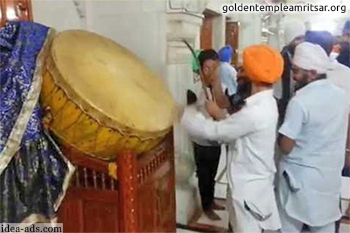
In most Gurudwaras the Nagara is absent and Prakaash time in the morning, during Ardaas time, and Sukhaasan time.
The massive drum with a metallic hemispheric body was called ‘Ranjit Nagara’, the drum of victory, a name given the kettledrum percussion instrument installed by Guru Gobind Singh Ji at Sri Anandpur Sahib in 1684. The Nagara, Punjabi for the Persian ‘naqqarah’ was a symbol of royalty. As well as fulfilling his spiritual office, Guru Gobind Singh Ji had, like his grandfather, Guru Hargobind Sahib Ji, adopted the emblems of worldly dignity. He wore a Kalgi and arms, sat under a canopy and went out riding in state. The installation of a Nagara was another sign of authority. Keeping and using a Nagara in the Gurdwara had become part of the Sikh tradition. The Nagara is beaten as a declaration of the sovereignty of the Khalsa, as a symbol of the sovereignty of truth and righteousness.